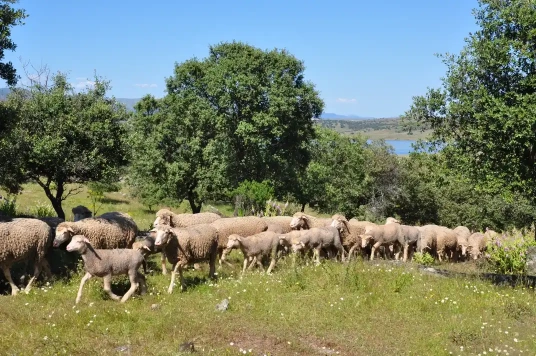The transhumance of Merino sheep in Spain is an agricultural practice that has been used since time immemorial. This is a form of animal husbandry in which herds are moved from one place to another to take advantage of pastures and food available at different times of the year.
This type of transhumant livestock follows seasonal cycles and uses specific routes known as “transhumant trails“. The transfer of animals is seasonal. During the warmer months, transhumant livestock are located in cooler areas such as northern Spain. In contrast, in the colder months of the year, cattle reside in warmer areas such as the south.
In many countries, transhumant livestock farming is considered a truly important economic activity. Especially in those countries that have a large extension of land and its climate is very varied depending on the region.
From the WWF WWF, make evident the lack of political support for transhumant livestock farming and all those families that practice it, which reach the figure of 10,000 in Spain. This practice, which is an example of respect for the environment and has many very important advantages for everyone, is in danger of extinction. Today, there are just over 300,000 head of transhumant cattle, compared to 5 million in the last century.
What does transhumance mean?
Broadly speaking, transhumant livestock farming is a way of life. It consists of moving livestock from warm to cold areas depending on the seasons of the year. For example, 99% of the Merino sheep of the Montes Universales variety are transhumant. In the summer and part of the fall, this transhumant livestock is located in Teruel to escape the sweltering heat, while the rest of the time it is protected from the cold in the south of Spain.
The objective of transhumant livestock farming is to promote the defense of native breeds and the conservation of local flora and fauna. Approximately each transhumant sheep transports 5,000 seeds and fertilizes the land with more than 3 kilos of manure daily.
Advantages of transhumant livestock farming
There are many advantages associated with transhumant livestock farming. On the one hand, it allows farmers to make efficient use of natural resources, as the animals consume pasture and feed that would otherwise be wasted. In addition, transhumant herds have the positive consequence of avoiding the overexploitation of a specific area.
In Spain, in recent years, fires have been increasing in number, and worse still, they have been devastating more and more hectares, as reflected in the data from Greenpeace . Transhumance helps us to avoid having uninhabited areas all year round and that livestock graze in more territories, thus making the mountain ranges, forests and pastures less lush, and therefore, helps to prevent fires.
Long distance transhumance
Long-distance transhumance, as we have explained above, consists of a journey made by herds along cattle trails in search of pasture to feed themselves. These roads or also called “Cañadas Reales”, the highest ranking, are the paths linking pastoral areas during transhumance in Spain.
Cañada Real Leonesa
The Cañada Real Leonesa is one of the two most important cattle trails for transhumant livestock in the Iberian Peninsula. Its route goes from León, passing through Extremadura and ending in Andalusia. The colder months are spent in the southern areas, while the warmer months are spent in the north.
Cañada Real Conquense
The busiest cattle trail in Spain today is the Cañada Real Conquense. The transhumant cattle herd travels, in its entirety every spring and autumn, through the provinces of Aragon, Castilla La Mancha and Andalusia. More specifically, passing through Sierra Albarracín, Teruel, Sierra Morena and Jaén. This route has an extension of approximately 400 km and lasts about 23 days.
This cattle route and the Merino sheep of the Montes Universales variety are synonymous. This variety of sheep makes use of this route in their transhumance. In short, it is important that transhumance livestock farmers who use this technique continue to use it. At the same time, it is necessary to recognize the importance of transhumant livestock as a source of food and as part of the culture and history of Spain.

